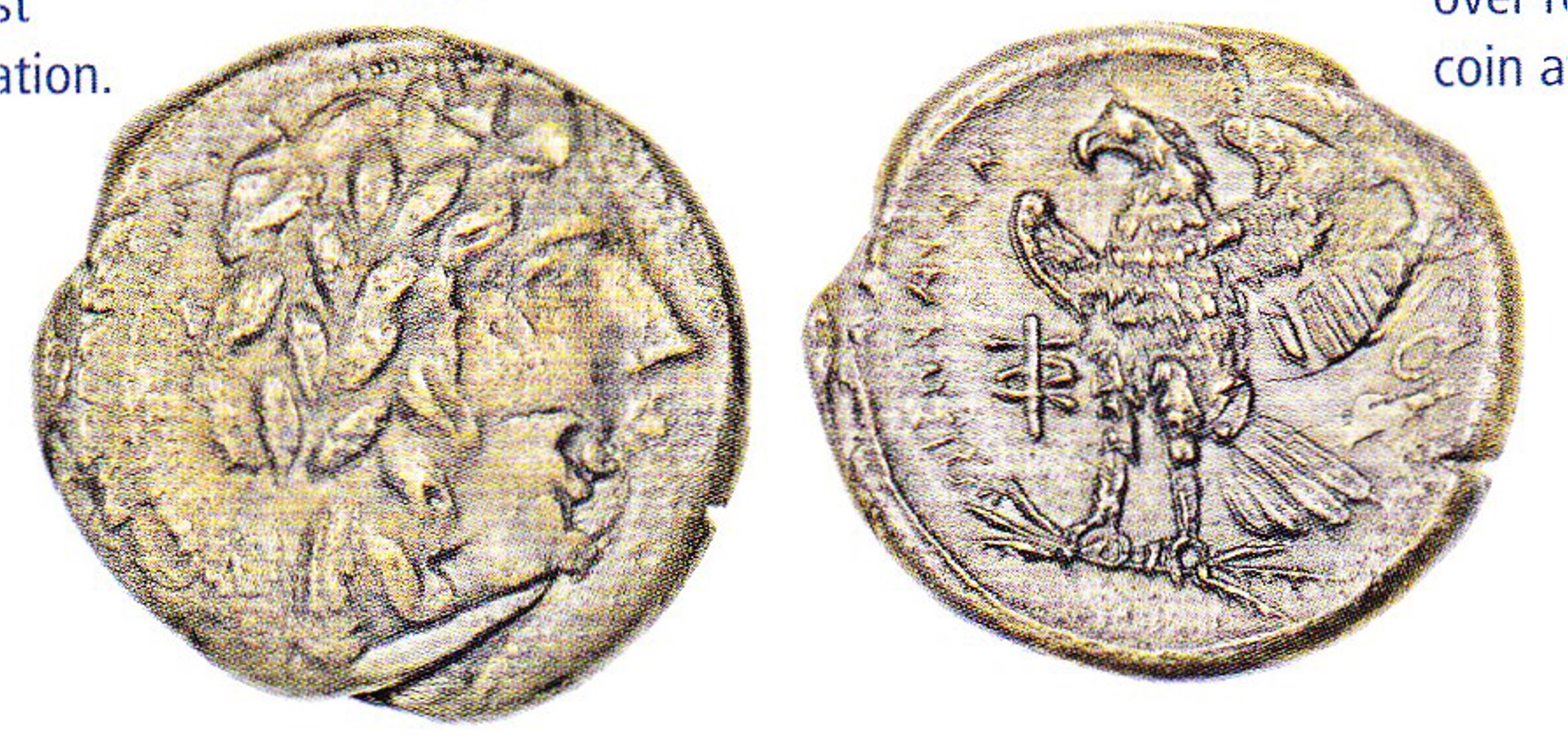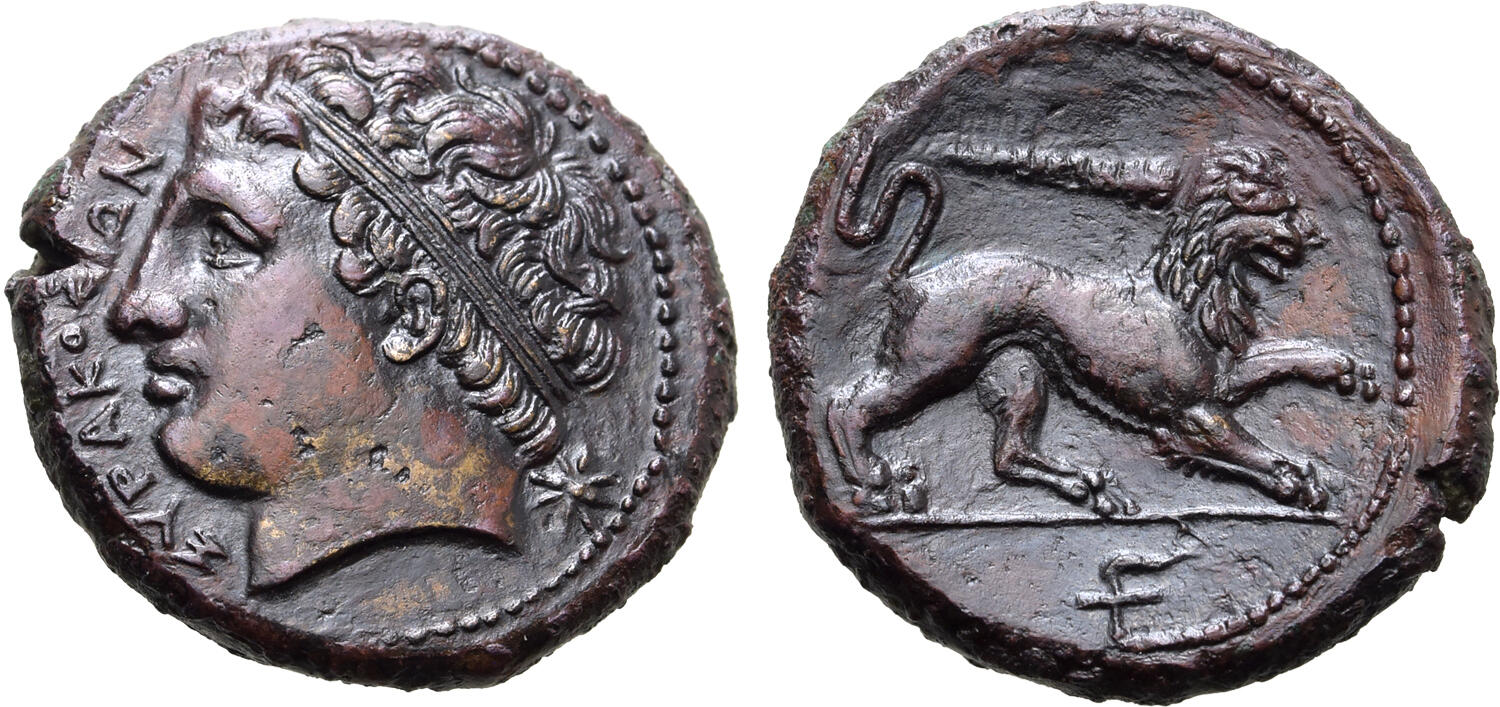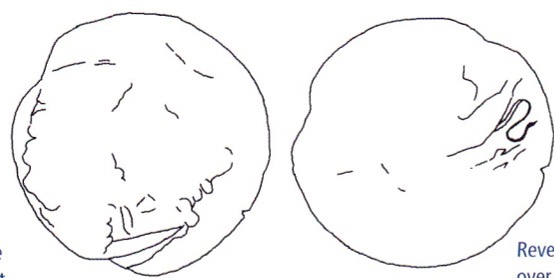287 BCE - 278 BCEΔΙΟΣ ΕΛΛΑΝΙΟΥ | ΩΙΣΩΚΑΙΩΝ (sic)
Overstriking coin
SO_1671_-_Syracuse_(AE_Zeus-eagle).jpg
Overstruck variety
Syracuse_Heracles-lion_HGC_2_1464.jpeg
[1]
1671_Syracuse_Heracles-lion_(drawing).jpg
Description
| ObverseInscription or printing placed on the obverse.:
|
ΔΙΟΣ ΕΛΛΑΝΙΟΥ (Greek) Head of Zeus Hellanios right, wearing laurel wreath. Border of dots.
|
ReverseInscription or printing placed on the reverse.:
|
ΩΙΣΩΚΑΙΩΝ (sic) (Greek) Eagle standing left on thunderbolt, with opened wings. In left field, monogram. Linear border.
|
Mint and issuing power
| MintIdentifies the place of manufacture or issue of a numismatic object.:
|
Syracuse
|
Ancient regionAncient region.
|
Sicily
|
Modern countryModern country: Italy
|
AuthorityIdentifies the issuing power. The authority can be "pretended" when the name or the portrait of X is on the coin but he/she was not the issuing power. It can also be "uncertain" when there is no mention of X on the coin but he/she was the issuing power according to the historical sources:
|
Hicetas (tyrant of Syracuse, 288-279 BC)
|
Chronology
| FromIdentifies the initial date in a range assigned in a numismatic context. 287 BCE toIdentifies the final date in a range assigned in a numismatic context.. 278 BCE
|
Hellenistic 323-30 BC  periodTime period of the numismatic object. periodTime period of the numismatic object.
|
Physical description
MetalThe physical material (usually metal) from which an object is made.: Bronze 
|
WeightWeight of the numismatic object (in grams). in grams: 9.749.74 g <br />9,740 mg <br />
|
DenominationTerm indicating the value of a numismatic object. Examples: tetradrachm, chalkous, denarius.: denomination A/B
|
AxisDescribes the directional relationship between the obverse and reverse of a numismatic object.: 44 mm <br />0.4 cm <br />
|
| DiameterDescribes diameter of an object (in mm).: 2323 mm <br />2.3 cm <br />
|
|
References
| Coin referenceReference of the Coin:
|
MacDonald 2009, p. 62, n° 44
|
Coin series referenceReference to coin series study:
|
Calciati 19861Calciati 1986, n° 157 (D112/R4 - imitation of this variety), p. 301-302, n° 167-8 (imitation of this variety), HGC 22HGC 2, n° 1449 (imitation of this variety), Puglisi 20093Puglisi 2009, p. 328, n° 326 (imitation of this variety)
|
| Coin series web referenceCoin series web references:
|
|
Description
| ObverseInscription or printing placed on the obverse.:
|
ΣΥΡΑΚΟΣΙΩΝ (Greek) Head of Herakles left (visible on obverse: profile of Herakles from forehead to lips, details of eye, much of outline of hair).
|
ReverseInscription or printing placed on the reverse.:
|
Lion right. Above, club (visible on reverse: rear leg and tail of lion, handle of club).
|
Mint and issuing power
Chronology
| FromIdentifies the initial date in a range assigned in a numismatic context. 289 BCE toIdentifies the final date in a range assigned in a numismatic context.. 287 BCE
|
Hellenistic 323-30 BC  periodTime period of the numismatic object. periodTime period of the numismatic object.
|
Physical description
| DenominationTerm indicating the value of a numismatic object. Examples: tetradrachm, chalkous, denarius. ᵖ:
|
denomination B
|
|
|
References
References
- a b Calciati, Romolo (1986), Corpus nummorum siculorum. La monetazione di bronzo/The bronze coinage, vol. 2, Milan, Edizioni G. M.
- a b Hoover, Oliver D. (2012), The Handbook of Greek Coinage Series. 2. Handbook of the Coins of Sicily (Including Lipara). Civic, Royal, Siculo-Punic, and Romano-Sicilian Issues. Sixth to First Centuries BC, Lancaster-London, 489 p.
- a b Puglisi, Mariangela (2009), La Sicilia da Dionisio I a Sesto Pompeo : circolazione e funzione della moneta, Messina, DiScAM, p. 519.
 Traces of the overstruck variety
Traces of the overstruck variety

